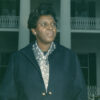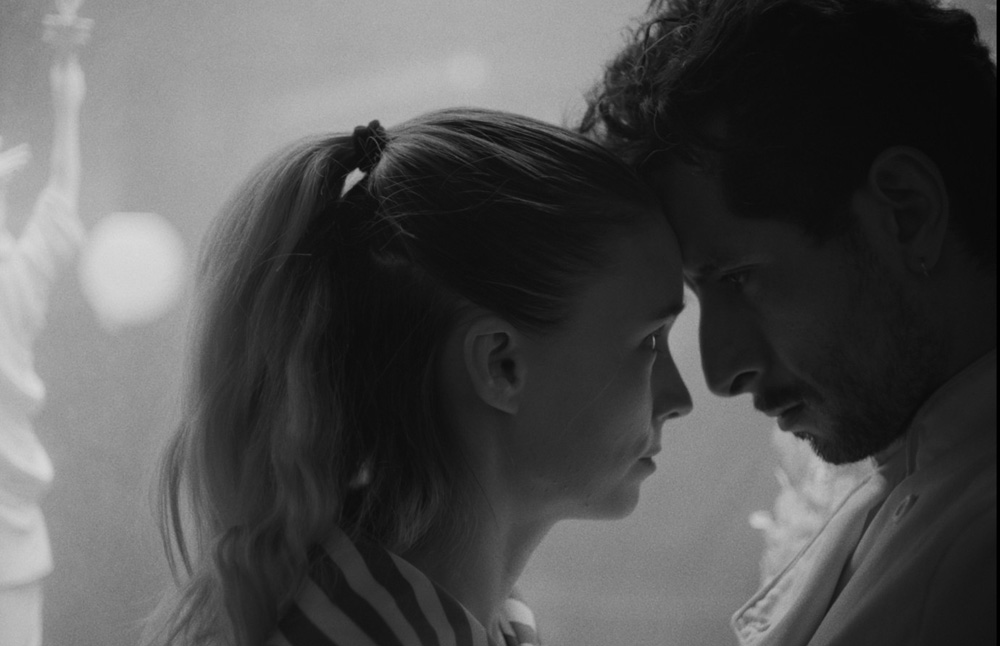”You ever see a body? This is the heart,” a man on the streets of Times Square can be heard saying in the opening minutes of “La Cocina,” trying to grab the attention of Estela (Anna Diaz), who is too busy to take notice when she’s trying to find The Grill, one of those tourist trap restaurants where she has a lead on a job. Just arrived in the U.S. from Mexico, she has little to work with, either in terms of resources or language, but she does have the name of one of the chefs – Pedro Ruiz (Raul Briones) – to get past the front door, bringing with her a type of oregano leaf indigenous to the region they both grew up in to remind him of who she is. It’s telling that he crushes it up almost immediately, making it into a sandwich quicker than she packed it into her suitcase to make the long journey to America.
Things that really matter have a way of being chewed up and spit out in Alonso Ruizpalacios’ magnificent fourth feature, taking inspiration from Arnold Wesker’s 1957 play “The Kitchen” and updating it with great aplomb when it resonated for him as he worked a day job at the Rainforest Cafe while attending drama school in the U.K. Estela may not have had the time to listen to the man on the street, but his words echo throughout “La Cocina” when she finds herself to be part of a crucial organ of a larger body on her first day on the job being in the heart of the heart of Times Square, weaving her way past Haitian dishwashers, Mexican cooks and a predominantly Caucasian American front of the house staff, all scraping by to make it to her work station and hanging on for dear life when the lunch rush comes.
Ruizpalacios stages a breathtaking quasi-musical number for a centerpiece when the operation is working properly, the energy of the moment making everyone an equal and their effort appreciated accordingly, but when service slows down or falters, the inequities start to surface as those working the hardest have the least to gain. While you have to wonder at first whether Estela will make it through the day, the story of survival shifts to Pedro, whose relationship with a waitress (Rooney Mara) has led to a pregnancy she can’t afford to carry to term and he’s become a prime suspect in the eyes of superiors when they get a whiff of their relationship and there’s a missing $800 from the till.
Whether those charges can be proven, Ruizpalacios illustrates a more profound theft taking place as employees are robbed of their dignity, clearly capable of so much more than what jobs they can get hired for and more tragically their time when it appears they’ve gotten on a hamster wheel where forward momentum is an illusion, with immigration papers promised by bosses with no intention of fulfilling them and career advancement largely a pipe dream. Since following a pair of brothers whose rebellion starts to transcend mere mischief making in his wily debut “Gueros,” the filmmaker has shown a real savvy for slyly exposing the cracks in a broken society and celebrating those who endure, considering the plunder of Mayan antiquities with the Gael Garcia Bernal heist comedy “Museo” and infiltrating Mexico City police quite literally in “A Cop Movie,” where its stars’ training for the roles involved engaging with real cops whose methodology could be questionable. (A full retrospective of Ruizpalacios‘ work in Los Angeles this week at the American Cinematheque, accompanying the release of “La Cocina” is well worth seeing, particularly when he uses a wide frame like no one else.)
“La Cocina” may be the director’s boldest swing to date, which is no small statement and with following its premiere in Berlin earlier this year, the film is beginning its U.S. theatrical run and Ruizpalacios graciously took the time to talk about its conception, making a film that mirrored its subject in appearing so simple as a single-setting drama that had endless complications and how it couldn’t be any more timely.
When I understand you’ve been carrying around thoughts of making this film for some time, what made this the right time to go through with it?
It’s a combination of factors. I came across this play that it’s based on by Arnold Wesker when I was in drama school over 20 years ago, so that’s where I got to know it and then I directed it as a stage play about 14 years ago. I started thinking of making it into a film back then and I originally thought this was going to be my first, but it was my fourth. It just took me a while to get the adaptation to a point where I was happy with it and where it felt like it wasn’t a piece of theater, but a real piece of cinema. Another factor was once I had the screenplay, it took a long time to find the right partners to produce it with because it was a very challenging film. I wanted a big period of rehearsals to get to improvise with the actors and that’s costly. Also, it was black and white. So it took a while to find the right people, but I think we got there.
Did staging it as a play actually give you any ideas for the choreography when it came to the film?
Yeah, that’s where the long period of rehearsals played in our favor. Everybody knew what their character was and all the actors went to cooking school, so they would learn really how to prepare each dish that their character is making, so when it came time to do the choreography of that long lunch rush scene, everybody knew what they were doing. We had already been very specific about creating this restaurant, and then it was just a matter of how to shoot it, so the big part of it was done before in prep.
Is it true the menu actually dictated the design of the kitchen?
Yeah, when we got to deciding the kitchen with a production designer, I started out [saying], “Well, the kitchen should be like this and like that” and we hired this executive chef to help us with all things kitchen, and he said, “No, no, wait, wait. This is not the way it works. Kitchens are designed according to the menu, so you have to first tell me what the menu is.” So we had to really reverse engineer the whole thing and start from, “Okay, what is this restaurant’s identity, what dishes does each character serve?” We created little maps of that and went through many iterations and then on the basis of that, we designed the architecture of the kitchen. Then the next layer of that was how to accommodate all those needs, but also make it look good on camera, so it was a continuous dance between what you really need for a restaurant to work and what you need for it to work on film. The time we were shooting, we really had a fully operational restaurant on a soundstage, essentially. It was quite a lot of fun, actually.
It’s obvious how you accommodate a large ensemble with a wide lens in those scenes that are one take, but it was equally impressive how you end up connecting a bunch of individual performances together when there’s a number of scenes with many different characters speaking almost directly to camera. Was it difficult to keep the energy the same in those moments in the edit?
Yeah, it is very much an ensemble piece, so it’s tough to keep all the plates spinning at the same time. Both on set and then later in the editing, it’s something that you have to [stay mindful of], “Well, we need to go and check back on this character and enhance him a little bit more, or this one a little bit less.” It was a constant balancing act. That started in the screenplay, obviously, but it was tricky and the rehearsal process really helped us in that. You know, if I ever make another ensemble piece, I know that rehearsals are key to find a common acting style, a common reality and a common language.
Was there anything that really took this film in a different direction that came from that time?
My approach to for this film and to film in general is to plan the shit out of it and then forget your plan and be open to the moment and to chance. This film was very much like that. We shortlisted and storyboarded most of it, but I didn’t follow my plan for many, many of the scenes. Some I did, but it’s good to allow yourself to be surprised on the set, and the actors were always coming up with great ideas — new stuff that really informed the script, and we did a lot of improvs [in the rehearsals] and rather than rehearsing the written scenes, I rehearsed improvs, analogous to those scenes in the script, so new material and interesting nuances would come off of that.
There’s a great sonic idea – this sound that I thought was something written on a pad and erased as a waiter would – that becomes a part of the rhythm of the film and the score itself it seems. Were ideas about the sound in mind from the start?
I love sound design. It’s probably the part that I enjoy most in making a film because all the agony has passed and now you’ve shot it and you’ve edited, or sometimes sound design really starts in the editing process, but it always just makes the film better, so it’s something that I like to spend a lot of time on, trying things. In this film, it was finding these points of contrast. When you’re in a kitchen, there are places that are very, very loud and when you come out, you really notice that change in pressure. So I wanted the audience to experience that build up of sound. There’s always constant rubble. The metallic banging is a quite a violent sound and in a way, it relates to to that Thoreau quote at the beginning of the film, “I’m awakened almost every day by the panting of the locomotive, it interrupts my dreams,” so I wanted to build this soundscape that was a dream killer, something that doesn’t allow you to think until Pedro steps out into the alley after the lunch rush and he finds a little peace. All the cooks find a little quiet and that deep contrast was key in the sound design.
The film in general seems like it provides a bit of clarity in a chaotic moment and when the play was written in the ‘50s, it spoke to you 20 years ago and you manage to make something relevant now out of it, what’s it like putting this out into the world now?
I’m saddened that it is timely in a way, and obviously it’s good for the film, but it’s not good for the world in general. When Thoreau wrote that quote, that was about 170 years ago, and it’s still relevant. Even then he was warning us about the perils of unchecked capitalism, and then when Wesker wrote [the play] in the ’50s, he was talking about that as well and now it’s very relevant. Plus, there’s this other layer that the film has about immigration, which the play touches upon, but in a broader way and there’s a humanitarian crisis around undocumented immigrants in the U.S. that hasn’t been addressed and seems only about to get worse, and this other issue that the film talks about of reproductive rights for women, [which] is sadly also very timely whether a woman can decide what she does with her own body or not. The fact that Julia has that dilemma will also be something that will have American audiences talking and thinking about.
“La Cocina” opens on October 25th in New York at the Village East and November 1st in Los Angeles at the Monica Film Center and San Francisco at the Roxie Theater. A full list of theaters and dates is here. It will also have a special screening in Los Angeles at AFI Fest on October 27th at the Chinese 6 at 1:45 pm and Alonso Ruizpalacios will have a retrospective of his work at the American Cinematheque with screenings of “Gueros” and “A Cop Movie” at the Los Feliz 3 on October 27th at 4 pm and 9:30 pm respectively and “La Cocina” and “Museo” at the Aero Theatre at 7:30 pm on October 29th.




